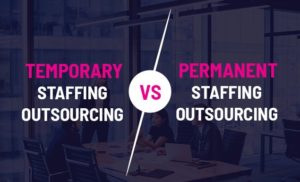Topics: Recruitment, Temp Recruitment
Is flexible workforce management costing your agency a fortune?
Posted on July 27, 2021
Written By
Aron Vaidya

Employers have always looked for a contingent workforce to solve their work crisis and add agility to their current workforce setup. Having a contingent workforce allows the company to carefully shuffle between its employees and assign them tasks suited to their capabilities. To hire this temp workforce is a growing practice, particularly after the COVID 19 outbreak.
Many work areas have more requirements of labor which are managed by the supply of contingent workforce. But this flexibility in the workforce also incurs certain costs. To fill the increasing demands of work and skill gap between the employees, the employers often end up paying a bit too much. This cost inefficiency may seem small at the beginning. But later, it may add up to a significant total.
What Leads To These Cost Inefficiencies?
Many reasons can contribute to the growing cost of hiring contingent labor. First of all, contingent labor is not included under the company’s fixed payroll. They are hired on a job basis for a particular tenure. Now depending upon the nature of the work and the tenure, the salaries are fixed. Having too much contingent labor can add up to the paying cost.
On the other hand, there are certain extra costs for maintaining the contingent workforce. One should also keep in mind the cost to keep managed staffing services providers and the VMSes they use. So, to figure out where the company is incurring more costs, one should start by chalking out all the areas that can add up to cost inefficiency.
Staffing Vendor Problem
The MSPs use various vendors to manage the staffing crisis in a company. The vendors assume responsibilities to supply contingent laborers from their source to the company. In exchange for this service, they charge the company various markups on an hourly basis. Now, this is the area where most companies end up incurring more costs than needed. The vendors often charge the companies more payment than that is necessary. Furthermore, as the payment is decided on an hourly basis of service, taking up more hours of the company can result in more significant payments.
Read more: What is MSP?
The main question is, why can’t the companies take any step to prevent this cost inefficiency? The answer is not that simple. The vendors don’t often break down the payment requirements. They hand over the total charge for their service. So it is pretty difficult for the company to figure out how much they are paying and why they are paying that much. Also, sometimes, the company may require immediate assistance with the workforce depending upon the urgency of the work. In that short time, it is pretty challenging to arrange for a contingent workforce from somewhere else. Thus the employer may end up paying extra payments as per the demands of the vendors. The requirement of rare talents also causes the cost incurrence to shoot up. But, talking solely about vendor markups, two main reasons can be highlighted for the growing costs.
Vendor Favoritism
It plays a significant part in the recruitment process of a contingent workforce. Vendor favoritism occurs when the hiring manager begins to favor one or two particular vendors above others. This shortens the options of staffing vendors a company may have and thus have to rely on those preferred vendors only. As a result, the vendors end up charging more money for their service as they can figure out the lack of alternatives. This happens due to the need for a temporary workforce within a fixed time and with no other vendor to go to. Thus the staffing vendors charge higher markups, and the company has to bear the payments, although it is a bit expensive.
Fragmented Buying Power
On the other hand, having too many staffing vendors to choose from may result in over expenses. This happens when different hiring managers representing different locations of services for the company end up hiring the vendors of their own choice. As a result, the company will have many vendors supplying a temp workforce, each at a different cost. The buying power of the company will get diluted due to this. Thus the company fails to negotiate a favorable markup and ends up paying more for all the vendors.
How To Resolve The Issue Regarding The Vendor Markup?
Having too many vendors can cause the same issues as having too few vendors to supply a contingent workforce. Thus a perfect balance of options should be present at the disposal of the company. The company must acquire a perfect balance of the number of vendors who will supply the required labor. There should be a handful of vendors among whom a healthy competition must exist. In this way, the company will be able to negotiate a reasonable markup for their service, and no vendor can charge more as they will be afraid to lose out to their competition. A healthy competition among the vendors can bring down the markup cost significantly.
To implement the said balance between the numbers of availed vendors, one can use the Vendor Management System. The VMS can quickly solve and produce results at the optimum level without involving many problems. As software, it can point to the exact requirement of staffing and how to avail them at a minimal rate.
The Issue Of Paying Above The Fair Market Rate
Another reason for cost inefficiency is not knowing what the fair market rate is. As a result, many employers end up paying more money than is required for the availed services. The various classes and services of workers availed by the companies can be categorized into several payment rankings. But the problem arises when an employer is charged more than the fair market rate for that particular class of workers. Thus, companies must form strategies and solutions to be aware of the ongoing market rates to prevent this from happening. Also, constant research is needed as the market rate changes at any given point and will not stay constant. The requirement and need of service may also go up and down. This, in return, may influence the market rate for availing that service or class of workers.
Are There More Sources Of The Contingent Workforce?
The companies often overlook any other possibilities or solutions that may solve the given problem and stick with a conventional solution only. The same thing happens when the hiring manager tends to rely heavily on the available staffing vendors for the supply of the contingent workforce. In reality, there are many other sources of availing the service of a non-permanent workforce other than hiring staffing vendors. For once, the company can start to build a talent pool of their own from which they can meet the requirements for contingent labor.
The talent pool can be created by appointing ex-employees, retirees, and other past contingent labor from different projects. Thus when in a crisis, the company can approach their talent pool to organize people willing to fill in as contingent workers for the task. The company can also create a mixture of permanent employees brought in from other departments and contingent labor. Thus, the right way of formulating a contingent labor talent pool strategy is to maintain records of all previously engaged workers and their areas of expertise. As a result, a database will be formed that can be accessed in the future, categorized into tasks, requirements, and services available.
The database may also contain referrals and high-value talents whom the company may have recognized earlier at some points. Furthermore, the alumni workers will be more accustomed to the company’s work culture and will be more suited to produce healthy working standards for others to follow. This will ensure an even distribution of responsibilities between the staffing vendors and other sources to supply a temp workforce. Thus the vendors will feel competitive in getting more service requests and will be bound to charge the company fairly or even give discounts on their services.
What Are The Hidden Costs Of A Contingent Workforce?
The company may fail to realize, but there are several hidden costs of having a contingent workforce. Many times, the company will end up paying more for having a flexible workforce. The main reason behind this is that most employers will consider the overlaying facts more promptly. They will think about vendor discretion, fair market rates, staffing issues arising from vendor management, and other significant details. But in reality, the company may incur extra costs from different hidden sources.
The main areas of cost incurrence in having a contingent workforce are – Payroll margin and Supplier margin. Most companies will focus mainly on these two components to devise plans for reducing the cost inefficiency. But what gets ignored is many hidden costs that lie under the tip of the iceberg. One must be familiar with all such hidden costs that may affect the company’s expenditure. Thus by doing so, the employer can prepare accordingly to devise cost-saving procedurals for each of them. Now, what are these hidden cost inefficiencies?
Invoice Errors-
This may sound insignificant at most times, but surprisingly this is the most common mistake while counting the cost. Due to time restraints and month-end pressure, the burden of invoice generation keeps piling. In addition to that, having much contingent labor will only add to that pressure. Therefore, silly mistakes at the time of calculation of costs can result in severe cost inefficiencies. This issue can be tackled by using a calculator or computational device during cost analysis.
Contract Notice Period Management-
It is important to keep the contracts up-to-date and properly managed. One should also keep the standard notice period updated in the contracts of the contingent workers. In that way, hidden costs can be saved.
Mandatory Leaves-
Having too many contingent workers on leave may hamper the productivity and performance of the company. Also, this will indirectly affect the company’s cost-efficiency. Thus employers should include clauses in the contract of contingent workers that will carry a set target, only upon achieving which the workers will be eligible to opt for leaves.
Asset Management-
Many times the contingent workforce requires a supply of standard assets. But due to lack of a proper off-boarding process, the assets are not fully recovered in the end. This incurs high costs on the company’s part.
Conclusion
There are many ways to minimalize the cost incurrence due to a flexible workforce. Having a contingent workforce is a blessing and serves greater purposes indeed. But one must not forget the hidden charges and several areas of costs incurrence that comes with their service. Thus the best way to manage the cost incurrence efficiently is to maintain a proper vendor management system. Along with this, taking help from managed staffing solutions providers will also level the playing ground for the employers.
QX Global Group offers outsourced recruitment support to staffing agencies and MSPs hiring and managing contingent workforce. Feel free to click the button below if you need temp staffing support.
Originally published Jul 27, 2021 02:07:38, updated Feb 05 2024
Topics: Recruitment, Temp Recruitment







